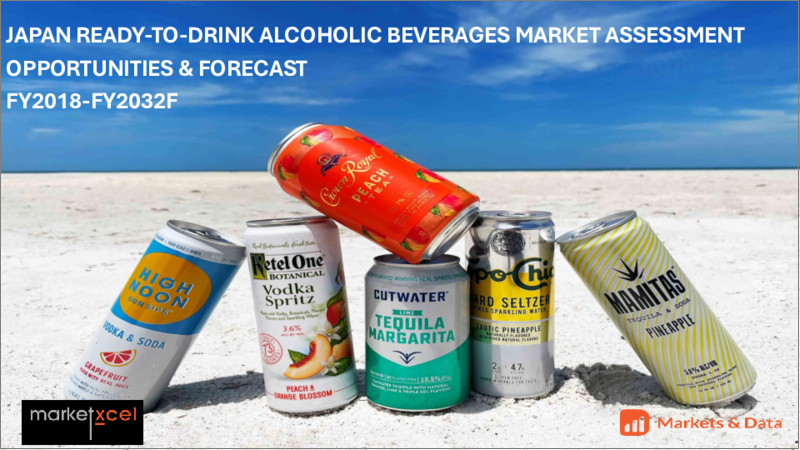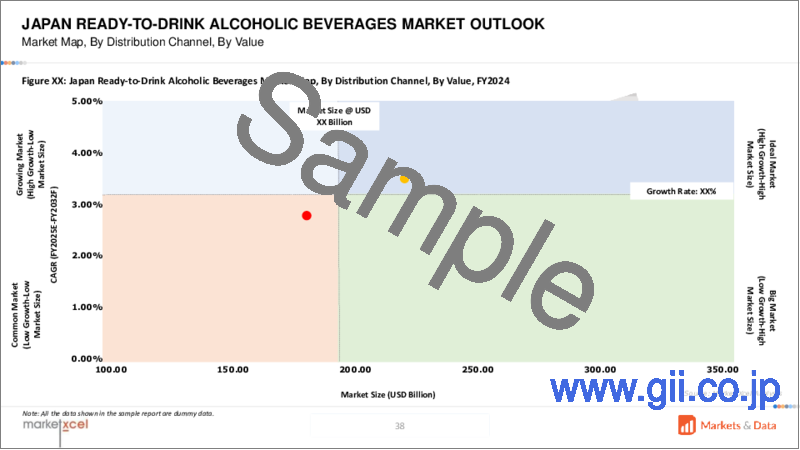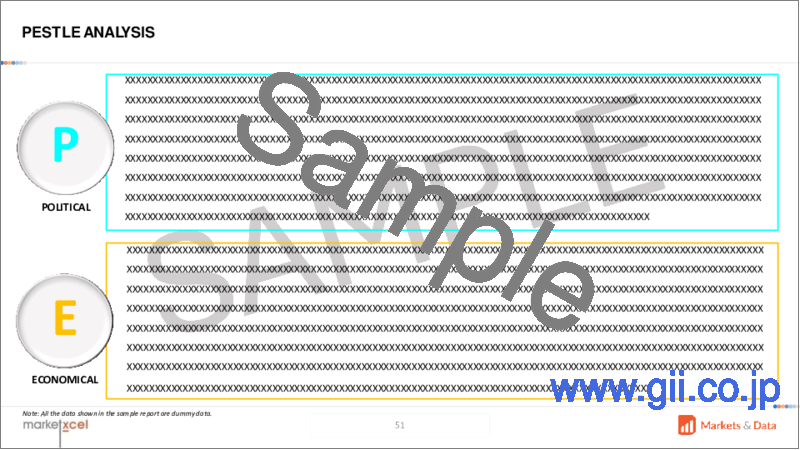|
|
市場調査レポート
商品コード
1491705
日本のRTDアルコール飲料市場の評価:製品別、ベースタイプ別、アルコール度数別、パッケージ別、エンドユーザー別、流通チャネル別、地域別、機会および予測、2018年~2032年Japan Ready-to-Drink Alcoholic Beverages Market Assessment, By Product, By Base Type, By Alcohol by Volume, By Packaging, By End-user, By Distribution Channel, By Region, Opportunities and Forecast, FY2018-FY2032F |
||||||
カスタマイズ可能
|
|||||||
| 日本のRTDアルコール飲料市場の評価:製品別、ベースタイプ別、アルコール度数別、パッケージ別、エンドユーザー別、流通チャネル別、地域別、機会および予測、2018年~2032年 |
|
出版日: 2024年06月10日
発行: Markets & Data
ページ情報: 英文 129 Pages
納期: 3~5営業日
|
全表示
- 概要
- 図表
- 目次
日本のRTDアルコール飲料の市場規模は、2024年に70億7,000万米ドルとなるとみられ、2032年には120億6,000万米ドルに達すると予測されており、2025年から2032年までの予測期間のCAGRは6.9%になる見込みです。同市場は、社交的な集まりやパーティーの魅力の高まり、自宅でカクテルを楽しむトレンドの台頭、さまざまなアルコール飲料を簡単に入手でき、手頃な価格で便利に楽しめる方法に対する消費者の動向など、いくつかの重要な要因によって拡大しています。
携帯性と消費のしやすさは、市場成長の主要な促進要因としてさらに貢献しています。消費者は、プレミックスされたプレミアムアルコール飲料を簡単かつ迅速に楽しむことができるため、外出先での消費にこれらの飲料を好みます。
さらに、マティーニやネグローニのような伝統的なアルコール飲料からフルーツビールのような型にはまらないアルコール飲料まで、幅広い種類の製品が入手可能であることも、日本のRTDアルコール飲料市場の成長を後押ししています。製品の風味が標準化される一方で、提供されるごとに高級感が維持されるため、消費者は親しみやすい味を感じ、それが製品との結びつきを強めます。さらに、アルコール飲料の時間節約オプションに対する消費者の嗜好が、こうしたレディ・トゥ・ドリンク(RTD)オプションの需要を促進しています。
当レポートでは、日本のRTDアルコール飲料市場について調査し、市場の概要とともに、製品別、ベースタイプ別、アルコール度数別、パッケージ別、エンドユーザー別、流通チャネル別、地域別動向、および市場に参入する企業のプロファイルなどを提供しています。
目次
第1章 調査手法
第2章 プロジェクトの範囲と定義
第3章 エグゼクティブサマリー
第4章 顧客の声
第5章 日本のRTDアルコール飲料市場の見通し、2018年~2032年
- 市場規模と予測
- 製品別
- ベースタイプ別
- アルコール度数(ABV)別
- パッケージ別
- エンドユーザー別
- 流通チャネル別
- 地域別
- 企業別市場シェア(%)、2024年
第6章 市場マッピング、2024年
第7章 マクロ環境と産業構造
- 供給需要分析
- 輸出入分析
- バリューチェーン分析
- PESTEL分析
- ポーターのファイブフォース分析
第8章 市場力学
第9章 主要参入企業の情勢
第10章 価格分析
第11章 ケーススタディ
第12章 主要参入企業の見通し
- Suntory Holdings Ltd
- Kirin Holdings Company, Limited
- Asahi Group Holdings Ltd
- DIAGEO Japan K.K.
- OENON Holdings, Inc.
- Coca-Cola Bottlers Japan Holdings Inc.
- Sapporo Breweries Limited
- AB InBev Japan LLC
- Hiro Sake, LLC
第13章 戦略的提言
第14章 お問い合わせと免責事項
List of Tables
- Table 1. Pricing Analysis of Products from Key Players
- Table 2. Competition Matrix of Top 5 Market Leaders
- Table 3. Mergers & Acquisitions/ Joint Ventures (If Applicable)
- Table 4. About Us - Regions and Countries Where We Have Executed Client Projects
List of Figures
- Figure 1. Japan Ready to Drink Alcoholic Beverages Market, By Value, In USD Billion, FY2018-FY2032F
- Figure 2. Japan Ready to Drink Alcoholic Beverages Market, By Volume, In Thousand Litres, FY2018-FY2032F
- Figure 3. Japan Ready to Drink Alcoholic Beverages Market Share, By Product, In USD Billion, FY2018-FY2032F
- Figure 4. Japan Ready to Drink Alcoholic Beverages Market Share, By Base Type, In USD Billion, FY2018-FY2032F
- Figure 5. Japan Ready to Drink Alcoholic Beverages Market Share, By Alcohol By Volume (ABV), In USD Billion, FY2018-FY2032F
- Figure 6. Japan Ready to Drink Alcoholic Beverages Market Share, By Packaging, In USD Billion, FY2018-FY2032F
- Figure 7. Japan Ready to Drink Alcoholic Beverages Market Share, By End-user, In USD Billion, FY2018-FY2032F
- Figure 8. Japan Ready to Drink Alcoholic Beverages Market Share, By Distribution Channel, In USD Billion, FY2018-FY2032F
- Figure 9. Japan Ready to Drink Alcoholic Beverages Market Share, By Region, In USD Billion, FY2018-FY2032F
- Figure 10. By Product Map-Market Size (USD Billion) & Growth Rate (%), FY2024
- Figure 11. By Base Type Map-Market Size (USD Billion) & Growth Rate (%), FY2024
- Figure 12. By Alcohol By Volume (ABV) Map-Market Size (USD Billion) & Growth Rate (%), FY2024
- Figure 13. By Packaging Map-Market Size (USD Billion) & Growth Rate (%), FY2024
- Figure 14. By End-user Map-Market Size (USD Billion) & Growth Rate (%), FY2024
- Figure 15. By Distribution Channel Map-Market Size (USD Billion) & Growth Rate (%), FY2024
- Figure 16. By Region Map-Market Size (USD Billion) & Growth Rate (%), FY2024
Japan ready-to-drink alcoholic beverages market was valued at USD 7.07 billion in FY2024, expected to reach USD 12.06 billion in FY2032, with a CAGR of 6.9% for the forecast period between FY2025 and FY2032. The market is expanding due to several important factors, including the increasing appeal of social gatherings and parties, rise of cocktail-at-home trend, and consumer preferences for easily accessible, reasonably priced, and convenient ways to enjoy a variety of alcoholic beverages.
The portability factor and ease of consumption further contribute as major drivers for the growth of the market. Consumers prefer these beverages for on-the-go consumption as they allow customers to enjoy their premixed premium alcoholic beverages easily and quickly.
Furthermore, the availability of a wider range of products, from traditional alcoholic beverages such as martinis and negronis to unconventional alcoholic beverages such as fruit beer, drives the growth of ready-to-drink alcoholic beverages market in Japan. The standardization of product flavors while maintaining premiumization with each serving gives consumers a familiar taste which helps them connect with the product. Moreover, consumers' preferences for time-saving options in alcoholic beverages fuels the demand for these ready-to-drink options.
Additionally, as customer demand for convenient alcoholic beverages rises, ready-to-drink beverages are becoming more common in the hospitality business, opening new revenue streams for restaurants, cafes, and other establishments. Furthermore, since customers seek unusual mixes in their alcoholic beverages, innovations such as alcoholic coffees and teas made by major players and other participants in the market are encouraging market growth.
Due to its wider market reach, ease of product availability for consumers increased brand visibility through exposure to offline retail locations and e-commerce websites, and rise in consumer sampling and tasting events hosted by various retail outlets, which give consumers a chance to try on the newest products on the market and give key players a chance to get feedback from them before launching their products, the retail distribution channel is dominating the ready-to-drink alcoholic beverages market.
Furthermore, with the expansion of AI in almost all sectors of the world, the ready-to-drink alcoholic beverages market in Japan is significantly impacted. The manufacturers are leveraging this not only in marketing campaigns and social media promotions but also in predicting the emerging trends in the country and producing highly tailored beverages. For instance, in March 2023, Sapporo Holdings initiated the use of artificial intelligence, cutting the time it takes to produce new goods in half to stay up with the rapidly evolving trends in the ready-made cocktail sector. In a few seconds, the technology provides 100 potential product formulations using a database including 1,200 formulas and 700 chemicals that Sapporo has already evaluated.
Portability, Affordability, and Convenience Factors to Support the Market Growth
The cost, portability, and ease of consumption of ready-to-drink alcoholic beverages have contributed to their increasing appeal. Ready-to-drink alcoholic beverages do not require laborious mixing or preparation steps, making them convenient for people with hectic schedules. A broad spectrum of customers find this simplicity appealing, especially those searching for easy and quick solutions for entertainment purposes or on-the-go. They are quite portable as they come in cans or bottles, making them suitable for various occasions such as festivals, beach parties, picnics, and outdoor gatherings. Ready-to-drink beverages are perfect for travel or outdoor activities where glassware is inconvenient or forbidden because the packaging guarantees freshness and minimized spills.
Additionally, as ready-to-drink alcoholic beverages are produced in large quantities and are marketed in single serving sizes, it lowers their production costs, reasonably pricing them for the general public. In April 2023, the first-ever ready-to-drink beverage combining Coca-Cola with an alcoholic beverage was launched in Japan with a suggested retail price of USD 1.55. The product, "Jack Daniel's & Coca-Cola," is a joint venture between Brown-Forman, the manufacturer of Tennessee Whiskey Jack Daniel's, and the Coca-Cola Company. It is produced after the much liked "Jack Coke" drink combo.
Malt-based RTD Alcoholic Beverages Dominate the Market
For several reasons, malt-based ready-to-drink alcoholic beverages outsell other types in the market, such as wine and spirit-based options. A wider range of customers, especially younger drinkers and those who are new to alcohol consumption, are drawn to the sweeter and more approachable flavor profile of malt-based ready-to-drink alcoholic beverages. The sweetness helps new drinkers tolerate the alcohol's taste by masking it.
Furthermore, compared to spirit-based beverages, malt-based ready-to-drink alcoholic beverages usually have a lower alcohol concentration, which makes them better suited for informal or social drinking events where moderation is sought. The reduced alcohol concentration is in line with consumers' shifting tastes for more health-conscious lifestyles and moderation in their drinking.
Moreover, a range of flavors are offered by malt-based RTDs, meeting the changing tastes of customers who want unique alcoholic drinks experiences.
RTD Beverages with Lower ABV Level Gaining Momentum
For a number of reasons, the growing demand for ready-to-drink alcoholic beverages with lower percentages of ABV is dominating Japan ready-to-drink alcoholic beverages market expansion. The demand for these beverages has increased as a result of consumer preferences shifting in favor of healthier lifestyles and overall wellness. Due to it, people are actively looking for alternatives to traditional alcoholic beverages which provide a similar taste without posing any health risks.
Furthermore, consumers who prefer lower ABV level beverages have more options and variety due to the growing popularity of zero-proof cocktails and low alcoholic spirits. For instance, young people prefer to enjoy drinks that are similar to those that include alcohol rather than consuming larger amounts of it, increasing the demand for ready-to-drink alcoholic beverages with lower ABV percentage. In fact, in February 2024, Asahi Breweries announced that it would not launch any new 'Chuhai' products with 8% or more ABV. The company expressed its willingness to shift to the low-alcohol alternatives catering to the evolving demands of consumers.
Future Market Scenario (FY2025 - FY2032F)
The growing demand and appeal for upscale, premium ready-to-drink alcoholic beverages are anticipated to fuel market expansion during the projected period.
The industry is expanding due to the introduction of the newest, most unusual flavors and inventive marketing tactics used by the major players.
Since ready-to-drink alcoholic beverages appeal to customers and give a hassle-free drinking experience, the introduction of innovative packaging solutions that boost portability and provide greater convenience to consumers will considerably encourage the growth of the ready-to-drink alcoholic beverage industry.
Key Players Landscape and Outlook
Major participants in the industry are fostering growth by emphasizing ongoing product innovation, store expansions, and targeted marketing. The producers are aggressively broadening their range of products, growing their clientele, expanding their global market share, and meeting the changing demands of consumers. For instance, in February 2024, Suntory Holdings Ltd announced the global expansion of its brand -196, a vodka-based fruit-flavored Japanese RTD beverage, to United States, Great Britain, Germany, and also within Southeast Asia. For successful expansion, the company is altering the beverage catering to the preferences of the people of a particular region.
In an effort to attract customers who value high-quality goods, prominent companies are introducing premium ready-to-drink alcoholic beverages. In September 2023, Kirin Holdings Company launched Kirin Tokusei Ginger Ale, a premium alcoholic ready-to-drink beverage with a mix of spicy and sweet flavor across Japan. The beverage is made up of sake containing 9% ABV giving a refreshing taste experience to consumers.
Table of Contents
1. Research Methodology
2. Project Scope and Definitions
3. Executive Summary
4. Voice of Customer
- 4.1. Demographics (Age/Cohort Analysis - Baby Boomers and Gen X, Millennials, Gen Z; Gender; Income - Low, Mid, and High; Geography; Nationality; etc.)
- 4.2. Product and Market Intelligence
- 4.3. Mode of Brand Awareness
- 4.4. Factors Considered in Purchase Decision
- 4.4.1. Quality
- 4.4.2. Taste
- 4.4.3. Brand Image
- 4.4.4. Product Variety and Range
- 4.4.5. Innovation
- 4.4.6. Price
- 4.4.7. Availability and Accessibility
- 4.4.8. Promotional Discounts
- 4.5. Consideration of Privacy and Safety Regulations
- 4.6. Purchase Channel
- 4.7. Frequency of Purchase
- 4.8. Existing or Intended User
- 4.9. Recommendations from friends, family/online reviews
- 4.10. Role of Brand Ambassador or Influencer Marketing on Product/Brand Absorption
5. Japan Ready-to-Drink Alcoholic Beverages Market Outlook, FY2018 -FY2032F
- 5.1. Market Size & Forecast
- 5.1.1. By Value
- 5.1.2. By Volume
- 5.2. By Product
- 5.2.1. Premixed Cocktails
- 5.2.2. Hard Seltzer
- 5.2.3. Alcopops
- 5.2.4. Others
- 5.3. By Base Type
- 5.3.1. Malt-based
- 5.3.2. Wine-based
- 5.3.3. Spirit-based
- 5.4. By Alcohol by Volume (ABV)
- 5.4.1. Below 5%
- 5.4.2. 5% to 10%
- 5.4.3. Above 10%
- 5.5. By Packaging
- 5.5.1. Bottles
- 5.5.2. Cans
- 5.5.3. Kegs
- 5.6. By End-user
- 5.6.1. Commercial
- 5.6.2. Residential
- 5.7. By Distribution Channel
- 5.7.1. Online
- 5.7.2. Offline
- 5.7.2.1. Convenience Stores
- 5.7.2.2. Liquor Stores
- 5.7.2.3. Supermarkets
- 5.7.2.4. HoReCa
- 5.7.2.5. Pubs
- 5.7.2.6. Others
- 5.8. By Region
- 5.8.1. North
- 5.8.2. Central
- 5.8.3. South
- 5.9. By Company Market Share (%), FY2024
6. Market Mapping, FY2024
- 6.1. By Product
- 6.2. By Base Type
- 6.3. By Alcohol by Volume (ABV)
- 6.4. By Packaging
- 6.5. By End-user
- 6.6. By Distribution Channel
- 6.7. By Region
7. Macro Environment and Industry Structure
- 7.1. Supply Demand Analysis
- 7.2. Import Export Analysis
- 7.3. Value Chain Analysis
- 7.4. PESTEL Analysis
- 7.4.1. Political Factors
- 7.4.2. Economic System
- 7.4.3. Social Implications
- 7.4.4. Technological Advancements
- 7.4.5. Environmental Impacts
- 7.4.6. Legal Compliances and Regulatory Policies (Statutory Bodies Included)
- 7.5. Porter's Five Forces Analysis
- 7.5.1. Supplier Power
- 7.5.2. Buyer Power
- 7.5.3. Substitution Threat
- 7.5.4. Threat from New Entrant
- 7.5.5. Competitive Rivalry
8. Market Dynamics
- 8.1. Growth Drivers
- 8.2. Growth Inhibitors (Challenges and Restraints)
9. Key Players Landscape
- 9.1. Competition Matrix of Top Five Market Leaders
- 9.2. Market Revenue Analysis of Top Five Market Leaders (By Value, FY2024)
- 9.3. Mergers and Acquisitions/Joint Ventures (If Applicable)
- 9.4. SWOT Analysis (For Five Market Players)
- 9.5. Patent Analysis (If Applicable)
10. Pricing Analysis
11. Case Studies
12. Key Players Outlook
- 12.1. Suntory Holdings Ltd
- 12.1.1. Company Details
- 12.1.2. Key Management Personnel
- 12.1.3. Products and Services
- 12.1.4. Financials (As reported)
- 12.1.5. Key Market Focus and Geographical Presence
- 12.1.6. Recent Developments
- 12.2. Kirin Holdings Company, Limited
- 12.3. Asahi Group Holdings Ltd
- 12.4. DIAGEO Japan K.K.
- 12.5. OENON Holdings, Inc.
- 12.6. Coca-Cola Bottlers Japan Holdings Inc.
- 12.7. Sapporo Breweries Limited
- 12.8. AB InBev Japan LLC
- 12.9. Hiro Sake, LLC
Companies mentioned above DO NOT hold any order as per market share and can be changed as per information available during research work






